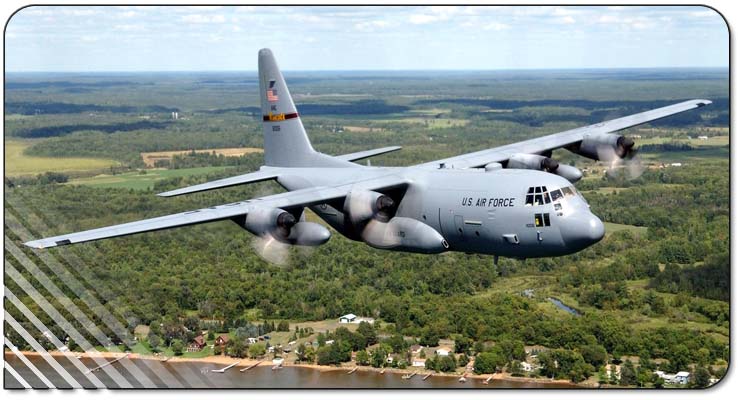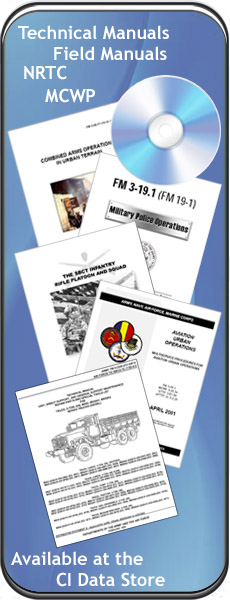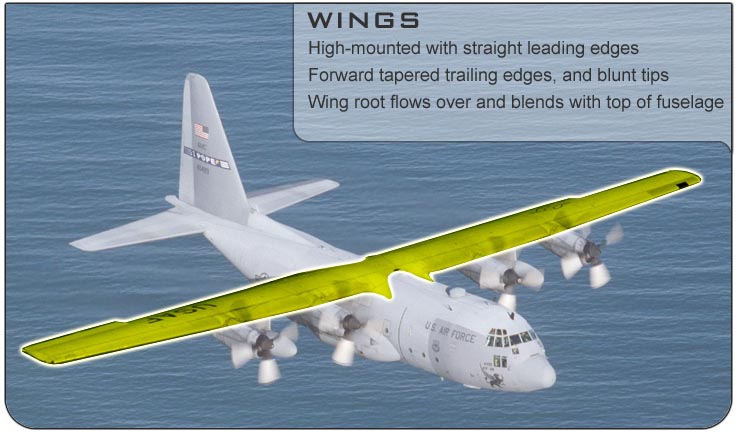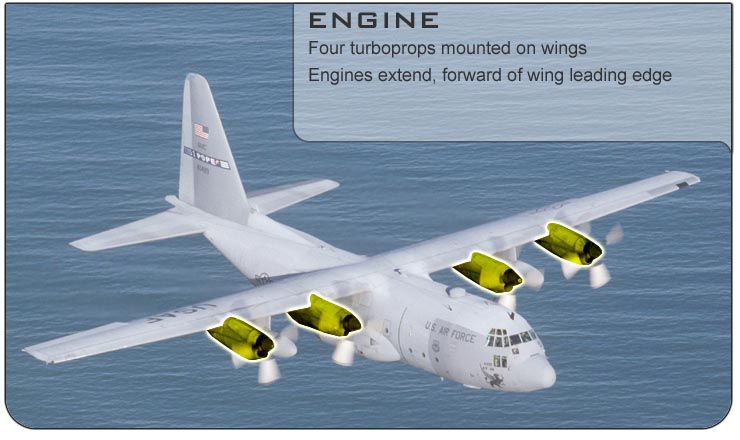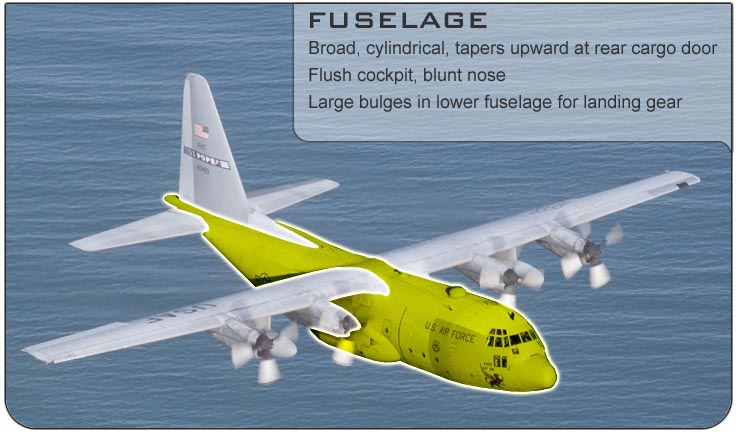Description: C-130 Hercules
The C-130
Hercules primarily performs the tactical portion of the airlift
mission. The aircraft is capable of operating from rough, dirt strips
and is the prime transport for air dropping troops and equipment into
hostile areas. The C-130 operates throughout the U.S. Air Force,
serving with Air Mobility Command (stateside based), Air Force Special
Operations Command, theater commands, Air National Guard and the Air
Force Reserve Command, fulfilling a wide range of operational missions
in both peace and war situations. Basic and specialized versions of the
aircraft airframe perform a diverse number of roles, including airlift
support, Antarctic ice resupply, aeromedical missions, weather
reconnaissance, aerial spray missions, fire-fighting duties for the
U.S. Forest Service and natural disaster relief missions.
Features:
Using its aft loading ramp and door the C-130 can accommodate a wide
variety of oversized cargo, including everything from utility
helicopters and six wheeled armored vehicles to standard palletized
cargo and military personnel. In an aerial delivery role, it can air
drop loads up to 42,000 pounds or use its high-floatation landing gear
to land and deliver cargo on rough, dirt strips. The flexible design of
the Hercules enables it to be configured for many different missions,
allowing for one aircraft to perform the role of many. Much of the
special mission equipment added to the Hercules is removable allowing
the aircraft to revert back to its cargo delivery role if desired.
Additionally, the C-130 can be rapidly reconfigured for the various
types of cargo such as palletized equipment, floor loaded material, air
drop platforms, container delivery system bundles, vehicles and
personnel or aeromedical evacuation. The C-130J is the latest addition
to the C-130 fleet and will replace aging C-130E's. The C-130J
incorporates state-of-the-art technology to reduce manpower
requirements, lower operating and support costs, and provide life cycle
cost savings over earlier C-130 models. Compared to older C-130s, the J
model climbs faster and higher, flies farther at a higher cruise speed,
and takes off and lands in a shorter distance. The C-130J-30 is a
stretch version, adding 15 feet to fuselage, increasing usable space in
the cargo compartment. C-130J/J-30 major system improvements include:
advanced two-pilot flight station with fully integrated digital
avionics; color multifunctional liquid crystal displays and head-up
displays; state-of-the-art navigation systems with dual inertial
navigation system and global positioning system; fully integrated
defensive systems; low-power color radar; digital moving map display;
new turboprop engines with six bladed, all composite propellers;
digital auto pilot; improved fuel, environmental and ice protection
systems; and an enhanced cargo handling system.
Background:
Four decades have elapsed since the Air Force issued its original
design specification, yet the remarkable C-130 remains in production.
The initial production model was the C-130A, with four Allison T56-A-11
or -9 turboprops. A total of 219 were ordered and deliveries began in
December 1956. The C-130B introduced Allison T56-A-7 turboprops and the
first of 134 entered Air Force service in May 1959. Introduced in
August of 1962, the 389 C-130E's that were ordered used the same
Allison T56-A-7 engine, but added two 1,290 gallon external fuel tanks
and an increased maximum takeoff weight capability. June 1974
introduced the first of 308 C-130H's with the more powerful Allison
T56-A-15 turboprop engine. Nearly identical to the C-130E externally,
the new engine brought major performance improvements to the aircraft.
The latest C-130 to be produced, the C-130J entered the inventory in
February 1999. With the noticeable difference of a six bladed composite
propeller coupled to a Rolls-Royce AE2100D3 turboprop engine, the
C-130J brings substantial performance improvements over all previous
models, and has allowed the introduction of the C-130J-30, a stretch
version with a 15-foot fuselage extension. Air Force has selected the
C-130J-30 to replace retiring C-130E's. Approximately 168 C-130J/J-30s
are planned for the inventory. To date, the Air Force has purchased 29
C-130J aircraft from Lockheed Martin Aeronautics Company. |
WEFT Description
-
- WINGS
- ENGINE
- FUSELAGE
- TAIL
|
|
Description: HC-130 Combat Shadow
Background:
The HC-130N/P Combat Shadow flies clandestine or low visibility,
low-level missions into politically sensitive or hostile territory to
provide air refueling for special operations helicopters. The HC-130
primarily flies its single- or multi-ship missions at night to reduce
detection and intercept by airborne threats. Secondary mission
capabilities include airdrop of small special operations teams and
small bundles, tactical airborne radar approaches and night vision
goggle takeoffs and landings.
Originally ordered in 1963 and first flown in 1964, the HC-130s have
served in many roles and missions. In the Vietnam War they were used to
refuel Jolly and Super Jolly Green Giant helicopters and, as an
airborne command post, to direct rescue efforts. Four aircraft were
modified to deploy and control 10,000-pound remotely piloted vehicles.
It was initially modified to conduct search and rescue missions,
provide a command and control platform, air refuel helicopters and
carry supplemental fuel for extending range or air refueling. In 1986,
the active-force HC-130 aircraft changed to a special operations
mission.
Air Force Special Operations Commands HC-130s were deployed to Saudi
Arabia and Turkey in support of Desert Storm. Their missions included
air refueling of special operations forces helicopters over friendly
and hostile territory, as well as psychological operations and leaflet
drop misions.
Features: The HC-130 has improved
navigation,
communications, threat detection, and countermeasures systems. When
fully modified, the Combat Shadow will have a self-contained navigation
system to include an inertial system, a global positioning system, and
interior and exterior lighting compatible with night vision goggles. It
will also have a forward looking infrared radar missile and radar
warning receivers, chaff and flare dispensers and a night-vision goggle
head-up display. In addition, it will have satellite communications, a
data burst device and in-flight refueling capability as a receiver.
Combat Shadow crews fly night, low level, air refueling and formation
operations using night-vision goggles. The aircraft's daytime role is
limited to reduced threat environments.
Note: These photos also include the US
Coast
Guard variant of the C-130, also designated HC-130. These aircraft are
easily distinguished by their US Coast Guard Orange-on-White paint
scheme. |
|
Description: EC-130E/J Commando Solo
Mission:
The EC-130E/J Commando Solo, a specially-modified four-engine Hercules
transport, conducts information operations, psychological operations
and civil affairs broadcasts in AM, FM, HF, TV and military
communications bands. A typical mission consists of a single-ship orbit
offset from the desired target audience -- either military or civilian
personnel.
Background: Commando Solo conducts
psychological operations and civil affairs broadcast missions in the
standard AM, FM, HF, TV and military communications bands. Missions are
flown at maximum altitudes possible to ensure optimum propagation
patterns. The EC-130 flies during either day or night scenarios with
equal success, and is air refuelable. A typical mission consists of a
single-ship orbit which is offset from the desired target audience. The
targets may be either military or civilian personnel. Secondary
missions include command and control communications countermeasures
(C3CM) and limited intelligence gathering. The three variants are
EC-130 ABCCC, EC-130E Commando Solo, and the EC-130H Compass Call.
The EC-130 was originally modified using the mission electronic
equipment from the EC-121, known at the time as the Coronet Solo. Soon
after the 193rd SOG received its EC-130s, the unit participated in the
rescue of US citizens in Operation Urgent Fury, acting as an airborne
radio station informing those people on Grenada of the US military
action. Commando Solo was instrumental in the success of coordinated
psychological operations in Operation Just Cause, again broadcasting
continuously throughout the initial phases of the operation to help end
the Noriega regime. Most recently, in 1994, Commando Solo was utilized
to broadcast radio and television messages to the citizens and leaders
of Haiti during Operation Uphold Democracy.
The EC-130s deployed early in the operation, highlighting the
importance of PSYOP in avoiding military and civilian casualties.
President Aristide was featured on the broadcasts which contributed
significantly to the orderly transition from military rule to
democracy. In 1990 the EC-130 joined the newly formed Air Force Special
Operations Command and has since been designated Commando Solo, with no
change in mission. This one-of-a-kind aircraft is consistently
improving its capabilities. The next few years should see continued
enhancements to the EC-130 and its worldwide mission.
Features: Highly specialized
modifications
have been made to the latest version of the EC-130 (Commando Solo).
Included in these mods are enhanced navigation systems, self-protection
equipment, and the capability of broadcasting color television on a
multitude of worldwide standards through out the TV VHF/UHF ranges. The
ABCCC is a an Airborne Battlefield Command and Control Center used as
an airborne command post. Last, but not least, Compass Call is an
airborne communications jamming platform. It was used extensively in
the Gulf War disrupting Iraqi communications at both the strategic and
tactical levels. |
|
Description: EC-130H Compass Call
Mission:
Compass Call is the designation of a modified version of the C-130
Hercules aircraft configured to perform tactical information warfare.
Specifically, the modified aircraft prevents or degrades communications
essential to command and control of weapon systems and other resources.
The system primarily supports tactical air operations, but also can
provide jamming support to ground forces and amphibious operations.
Background: In the world of airborne
electronic warfare, the major players are the EC-130H Compass Call, the
EA-6B Prowler and F-16CJ Fighting Falcons. Forming the "suppression of
enemy air defenses triad," these forces jam communications and radar
and destroy critical air defense and command and control targets.
Compass Call is tasked by all the unified commands, and therefore,
subject to worldwide deployment in support of tactical air, ground and
amphibious forces on very short notice.
All Compass Call aircraft are assigned to Air Combat Command. The
EC-130H Compass Call is operated by the 41st and 43d Electronic Combat
Squadrons at Davis-Monthan Air Force Base, Ariz. Although located at
Davis-Monthan, the squadrons report to the 55th Wing at Offutt AFB,
Neb.
Features: Modifications to the aircraft
include the primary mission equipment, an air refueling capability and
associated navigation and communications systems. Compass Call has
demonstrated its powerful effect on enemy command and control networks
in military operations over Kosovo, Haiti, Panama, Iraq, Serbia and
Afghanistan.
The EC-130H aircraft carries a combat crew of 13 people. Four members
are responsible for aircraft flight and navigation from the flight
deck, while nine members operate and maintain the Compass Call primary
mission equipment at the rear of the aircraft. The mission crew
consists of an electronic warfare officer, who is the mission crew
commander; an experienced cryptologic linguist is the mission crew
supervisor; four analysis operators; one high band operator, one
acquisition operator and an airborne maintenance technician.
Compass Call integrates into tactical air operations at any level. The
versatile and flexible nature of the aircraft and its crew enable the
power of electronic combat to be brought to bear in virtually any
combat situation. |
|
Description: MC-130E/H Combat Talon I/II
Background:
The mission of the MC-130E/H Combat Talon I and II is to provide
global, day, night, and adverse weather capability to airdrop and
airland personnel and equipment in support of U.S. and allied special
operations forces. These aircraft are equipped with aerial refueling
equipment, terrain following, terrain-avoidance radar, an inertial
navigation system, and a high speed aerial delivery system. The special
navigation and aerial delivery systems are used to locate small drop
zones and deliver people or equipment with greater accuracy and at
higher speeds than possible with a standard C-130. The aircraft is able
to penetrate hostile airspace at low altitudes. Crews are specially
trained in night and adverse weather operations.
During Desert Storm, the MC-130E Combat Talon I played a vital role.
The first airdrops of the war were performed exclusively by the 7th
Special Operations Squadron. One third of all airdrops in the first
three weeks of the war were performed by MC-130s. In its primary role
of psychological operations, the MC-130E air-dropped 11 15,000-pound
BLU-82/B general purpose bombs and flew multiple missions air-dropping
and dispersing leaflets. Its secondary role was combat search and
rescue. Following the Persian Gulf war, MC-130s flew extensively in
support of Operation Provide Comfort.
Features: The MC-130H features highly
automated controls and displays to reduce crew work load. The
integrated control and display subsystem combines basic aircraft flight
, tactical and mission sensor data into a comprehensive set of display
formats. The pilot and copilot displays and the navigator and
electronic warfare operator console on the aft portion of the flight
deck each have two video displays and a data entry keyboard. The
navigator uses radar ground map displays, forward looking infrared
display, tabular mission management displays, and equipment status
information. The electronic warfare operator's displays are used for
viewing the electronic warfare data and to supplement the navigators in
certain critical phases.
The MC-130E is equipped with a surface-to-air Fulton recovery system, a
safe, rapid method of recovering personnel or equipment from either
land or water. It involves use of a large, helium filled balloon used
to raise a 450-foot nylon lift line. The MC-130E flies to the lift
line, snags it with scissors-like arms located on the aircraft nose and
the person or equipment is lifted off, experiencing less shock than
that caused by a parachute opening. Aircrew members then use a
hydraulic winch to pull the person or equipment aboard through the open
rear cargo door. |
|
Description: MC-130P Combat Shadow
Mission:
The Combat Shadow flies clandestine or low visibility, single or
multi-ship low-level missions intruding politically sensitive or
hostile territory to provide air refueling for special operations
helicopters. The MC-130P primarily flies missions at night to reduce
probability of visual acquisition and intercept by airborne threats.
Secondary mission capabilities may include airdrop of leaflets, small
special operations teams, bundles and combat rubber raiding craft, as
well as night vision goggles, takeoff and landing procedures and
in-flight refueling as a receiver.
Features: Recent modifications to the
MC-130P
feature improved navigation, communications, threat detection and
countermeasures systems. The Combat Shadow fleet has a fully-integrated
inertial navigation and global positioning system, and night vision
goggle compatible interior and exterior lighting. It also has forward
looking infrared, radar and missile warning receivers, chaff and flare
dispensers, night vision goggle compatible heads-up display, satellite
and data-burst communications, as well as in-flight refueling
capability as a receiver (on 15 aircraft). The Combat Shadow can fly in
the day against a low threat. The crews fly night low-level, air
refueling and formation operations using night vision goggles. To
enhance the probability of mission success and survivability near
populated areas, employment tactics incorporate no external lighting
and no communications to avoid radar and weapons detection. |
|
Description: WC-130H Hercules
Mission:
The WC-130 Hercules is a high-wing, medium-range aircraft flown by the
Air Force Reserve Command for weather reconnaissance missions.
Features: The WC-130H is capable of
staying
aloft nearly 15 hours during missions. It is equipped with two external
1,400 gallon (5,320-liter) fuel tanks, an internal 1,800 gallon (6,480
liter) fuel tank, and has uprated engines. An average weather
reconnaissance mission might last 11 hours and cover almost 3,500 miles
while the crew collects and reports weather data every minute. Weather
equipment aboard the aircraft include the Improved Weather
Reconnaissance System (IWRS). This system consists of the Atmospheric
Distributed Data System (ADDS) and Omega Dropsonde Windfinding System
(ODWS).
The ADDS system provides a high-density, high-accuracy horizontal
atmospheric sensing capability. Sensors installed on the aircraft
measure per second outside temperature, humidity, absolute altitude of
the aircraft, pressure altitude, wind speed and direction. This
information, along with an evaluation of other meteorological
conditions, turbulence, icing, radar returns and visibility, is encoded
by the onboard meteorologist and transmitted by satellite to the
National Weather Services' National Hurricane Center in Miami, Fla.
The ODWS system measures the atmosphere vertically by using an
expendable instrument which is dropped from the aircraft. The 16
inch-long cylinder is dropped every 400 miles while on a weather track
and in the center or hurricane eye. A vertical atmospheric profile of
pressure, temperature, humidity, barometric pressure, wind speed and
direction is received from the dropsonde as it descends to the ocean
surface. The dropsonde is slowed and stabilized by a small parachute.
From this information, the dropsonde system operator analyzes and
encodes data for satellite transmission to the National Hurricane
Center.
The WC-130 is flown exclusively from Keesler Air Force Base, Miss., by
the 53rd Weather Reconnaissance Squadron, an AFRC organization known as
the Hurricane Hunters. The hurricane reconnaissance area includes the
Atlantic Ocean, Caribbean Sea, Gulf of Mexico and eastern Pacific Ocean
areas.
Background: The WC-130H Hercules is a
modified
version of the C-130 transport configured with computerized weather
instrumentation for penetration of severe storms to obtain data on
storm movements, dimensions and intensity. The WC-130B became
operational in 1959, the E model in 1962, followed by the H model in
1964. Only the H model is currently in operation. The WC-130J,
currently in testing, is scheduled to replace the WC-130H.
The WC-130 provides vital tropical cyclone forecasting information. It
penetrates tropical cyclones and hurricanes at altitudes ranging from
500 to 10,000 feet (151.7 to 3,033.3 meters) above the ocean surface
depending upon the intensity of the storm. The aircraft's most
important function is to collect high-density, high-accuracy weather
data from within the storm's environment. This includes penetration of
the center or hurricane eye of the storm. This vital information is
instantly relayed by satellite to the National Hurricane Center to aid
in the accurate forecasting of hurricane movement and intensity. |
|
PHOTOS: C-130
Click on images for larger view
|
|
PHOTOS: HC-130
Click on images for larger view
|
More Photos: 1
| 2 | 3 | 4 | 5
| 6 | 7 | 8 | 9 | 10
|
|
PHOTOS: EC-130
Click on images for larger view
|
More Photos: 1
| 2 | 3 | 4 | 5
| 6 | 7 | 8 | 9 | 10
|
|
PHOTOS: MC-130
Click on images for larger view
|
More Photos: 1
| 2 | 3 | 4 | 5
| 6 | 7 | 8 | 9 | 10
|
|
PHOTOS: WC-130
Click on images for larger view
|
More Photos: 1
| 2 | 3 | 4 | 5 | 6 | 7 | 8 | 9 | 10
|
|
PHOTOS: KC-130
Click on images for larger view
|
More Photos: 1
| 2 | 3 | 4 | 5 | 6 | 7 | 8 | 9 | 10
|
More Photos (KC-130J): 1
| 2 | 3 | 4 | 5
| 6 | 7 | 8 | 9 | 10
|
|
PHOTOS: LC-130
Click on images for larger view
|
More Photos: 1
| 2 | 3 | 4 | 5
|
|
